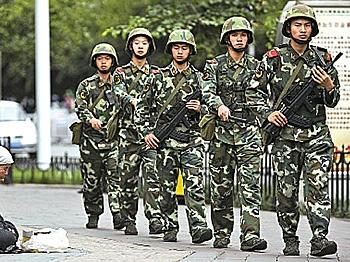In the recent Olympic Games history, from 1976 to 2004, the Olympic torch has died-out a total of six times, despite facing various weather conditions and obstacles. However, during this year’s relay the torch has died-out so frequently that nobody can accurately recall the exact number of occasions.
The Beijing Olympic torch was equipped with an internal ignition device, designed to automatically re-light the torch if it was accidentally extinguished. Using cutting-edge space technology, it was proclaimed to be able to withstand gale-force winds, and other severe weather conditions.
A Beijing space shuttle expert once bragged, “This torch won’t go out even in a tsunami".
However, it seems that even the latest technology was somehow not enough keep China’s Olympic torch alive, and Chinese people have started to wonder if this is a bad omen.
If so, it seems that the alarm bells have been sounding since the relay began, with most of the torch’s journey marred by disaster and suffering.
When the relay began in Greece on August 24, 2007, the nation was swallowed by the most ferocious fires in decades. By August 26, the fire had raged towards the Peloponnese peninsula in southern Greece, threatening the birthplace of the Olympic flame—the site of the ancient city of Olympia. Miraculously enough, the ruins of the city escaped the disaster, but the location nominated for the lighting ceremony for the Olympic torch was completely destroyed.
The next hurdle occurred during the unsuccessful rehearsals for the Olympic flame-lighting ceremony in March 2008, where two out of three lighting attempts failed. Eventually, the torch was lit from a tinder instead of from direct sunlight, which is the traditional method.
The actual lighting ceremony was also far from perfect.
Shortly after Beijing Olympic Organizing Committee President Liu Qi commenced his opening speech, three protesters from Reporters Without Borders unfurled a banner and shouted “Freedom! Freedom!”, urging the international community to boycott the Beijing Games. China’s state-run television was forced to cut the live broadcast to avoid the scene being displayed to Chinese audiences.
The Beijing Olympic torch was equipped with an internal ignition device, designed to automatically re-light the torch if it was accidentally extinguished. Using cutting-edge space technology, it was proclaimed to be able to withstand gale-force winds, and other severe weather conditions.
A Beijing space shuttle expert once bragged, “This torch won’t go out even in a tsunami".
However, it seems that even the latest technology was somehow not enough keep China’s Olympic torch alive, and Chinese people have started to wonder if this is a bad omen.
If so, it seems that the alarm bells have been sounding since the relay began, with most of the torch’s journey marred by disaster and suffering.
When the relay began in Greece on August 24, 2007, the nation was swallowed by the most ferocious fires in decades. By August 26, the fire had raged towards the Peloponnese peninsula in southern Greece, threatening the birthplace of the Olympic flame—the site of the ancient city of Olympia. Miraculously enough, the ruins of the city escaped the disaster, but the location nominated for the lighting ceremony for the Olympic torch was completely destroyed.
The next hurdle occurred during the unsuccessful rehearsals for the Olympic flame-lighting ceremony in March 2008, where two out of three lighting attempts failed. Eventually, the torch was lit from a tinder instead of from direct sunlight, which is the traditional method.
The actual lighting ceremony was also far from perfect.
Shortly after Beijing Olympic Organizing Committee President Liu Qi commenced his opening speech, three protesters from Reporters Without Borders unfurled a banner and shouted “Freedom! Freedom!”, urging the international community to boycott the Beijing Games. China’s state-run television was forced to cut the live broadcast to avoid the scene being displayed to Chinese audiences.






